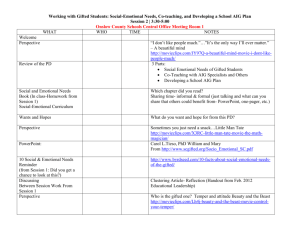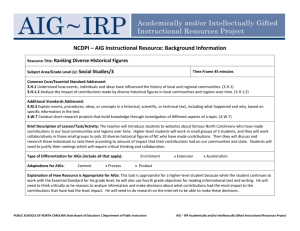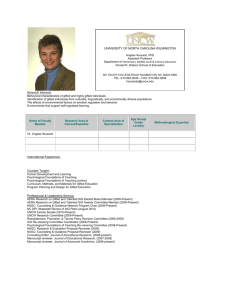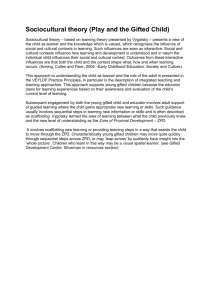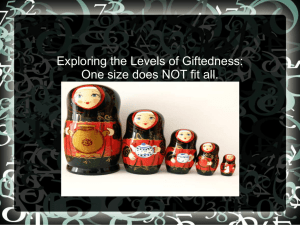File - caroline suddreth. weebly.com
advertisement
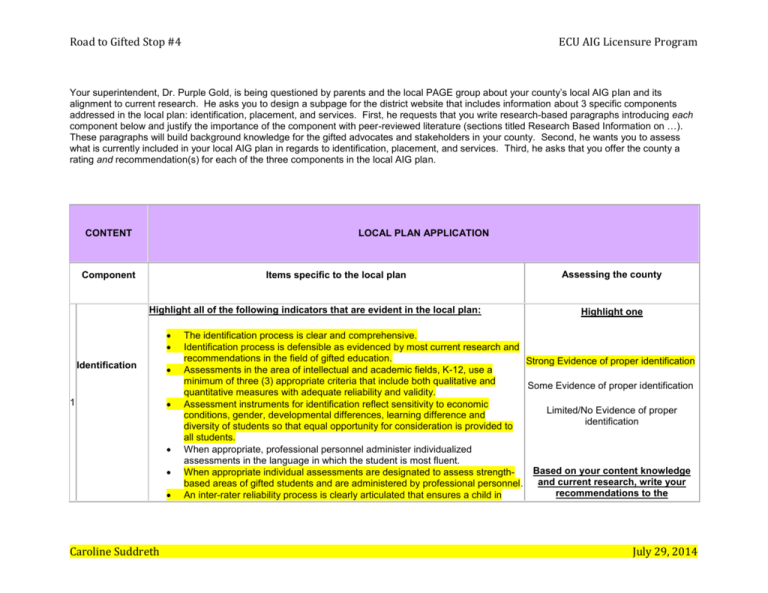
Road to Gifted Stop #4 ECU AIG Licensure Program Your superintendent, Dr. Purple Gold, is being questioned by parents and the local PAGE group about your county’s local AIG plan and its alignment to current research. He asks you to design a subpage for the district website that includes information about 3 specific components addressed in the local plan: identification, placement, and services. First, he requests that you write research-based paragraphs introducing each component below and justify the importance of the component with peer-reviewed literature (sections titled Research Based Information on …). These paragraphs will build background knowledge for the gifted advocates and stakeholders in your county. Second, he wants you to assess what is currently included in your local AIG plan in regards to identification, placement, and services. Third, he asks that you offer the county a rating and recommendation(s) for each of the three components in the local AIG plan. CONTENT LOCAL PLAN APPLICATION Component Items specific to the local plan Highlight all of the following indicators that are evident in the local plan: Identification 1 Caroline Suddreth Assessing the county Highlight one The identification process is clear and comprehensive. Identification process is defensible as evidenced by most current research and recommendations in the field of gifted education. Strong Evidence of proper identification Assessments in the area of intellectual and academic fields, K-12, use a minimum of three (3) appropriate criteria that include both qualitative and Some Evidence of proper identification quantitative measures with adequate reliability and validity. Assessment instruments for identification reflect sensitivity to economic Limited/No Evidence of proper conditions, gender, developmental differences, learning difference and identification diversity of students so that equal opportunity for consideration is provided to all students. When appropriate, professional personnel administer individualized assessments in the language in which the student is most fluent. Based on your content knowledge When appropriate individual assessments are designated to assess strengthand current research, write your based areas of gifted students and are administered by professional personnel. recommendations to the An inter-rater reliability process is clearly articulated that ensures a child in July 29, 2014 Road to Gifted Stop #4 ECU AIG Licensure Program superintendent: School A identified as gifted using a minimum of three (3) appropriate criteria that include both qualitative and quantitative measures with adequate reliability and validity would also be identified as gifted using the same criteria in School B. The identification process is designed to organize multiple kinds of data free of 1.The Lenoir County Public Schools weighing and cut-off scores. (LCPS) AIG plan needs to specifically address how to identify students who Additional Notes: may be considered “twice-exceptional”. Lenoir County’s current plan does not specifically mention testing students through the 2.Since schools are so diverse and rich use of their native language. The plan does specify that a non-verbal assessment will in various cultures, the AIG plan needs be used during the identification process for non-represented populations. to have a component that identifies a specific protocol for identifying gifted students in minority groups. The current plan does mention under represented populations, but it needs to have more specific information so we can be sure to properly identify kids who are in the minority group. 3.Instead of waiting until second grade to identify students, identification should begin at the preschool level. Because pre-K programs are common throughout our county, our plan should have a component that specifies how to identify gifted preschool-aged students. When identifying AIG students, it is important to take a multidimensional approach (Davis, Rimm, & Siegle, 2011). Instead of using only one method of identification, for example a single test score, many factors should play a part in Research Based determining if a child is gifted. While formal intelligence tests should be taken into consideration, evaluators should also Information on consider creativity, teacher nominations, parent/peer nominations and self-nominations (Davis, Rimm, & Siegle, 2011). IDENTIFICATION Pinpointing a child’s giftedness through the use of one finite test not only closes the doors for many students who are indeed gifted, but also showcases only one part of a gifted child’s abilities. Some students are classified as “twice exceptional”, meaning they are gifted but also have one or more disabilities Caroline Suddreth July 29, 2014 Road to Gifted Stop #4 ECU AIG Licensure Program (Davis, Rimm, & Siegle, 2011). The types of twice-exceptional students that exist in our schools today fall in one of the three following categories: identified as AIG but struggling, identified as exceptional because of a disability, but not as gifted and lastly, students who are unqualified for services (Beckley, 1998). These students are often times never identified as gifted because of their pre-existing disabilities that cause them to be overlooked (Beckley, 1998). Again, to identify a child who is twice-exceptional, the process must be multidimensional. If it is suspected that a child may be twice-exceptional, the child’s school should provide a comprehensive assessment (Gilman, et al., 2013). Parents should play a large role during the identification process. Parents should request an assessment for their child and should be actively involved throughout the whole process (Gilman, et al., 2013). Those in a school system, along with legislators, should ensure twice-exceptional students are being served by creating legislation and programs that specifies exactly what the children are in need of to work to their highest ability (Gilman, et al., 2013). Also, students who are twice-exceptional should use self-nominations and portfolios as a method for identification (Beckley, 1998). When it comes to identifying giftedness, special attention needs to be paid to minority students. There are two types of gifted individuals, “high-accomplishment students” and “high-potential students” (Lohman, 2005). Students who are recognized as high-accomplishment students perform well and are easily identified, while high potential students may not stand out as easily as their gifted peers (Lohman, 2005). Minority students commonly fall into the high-potential category because they have not had as many opportunities to progress academically like their majority counterparts (Lohman, 2005). To guarantee minority students are being identified, school systems should evaluate the educational options currently in place, decide how to measure student accomplishment and their potential accomplishment, find a way to measure a child’s aptitude reliably and validly, create a policy to ensure minorities are properly represented, use accomplishments to determine a child’s giftedness, and compare minorities to like-peers (Lohman, 2005). AIG identification should begin earlier than second grade. Research has been conducted that suggests students as early as preschool can show gifted and talented qualities (Davis, Rimm, & Siegle, 2011). In our county we have growing 3-yearold and Pre-K programs within many of our elementary schools. Parents and community members alike should be made aware of this information. I would encourage our superintendent to have preschool teachers trained to pinpoint student behaviors that seem advanced or gifted. Once kids have shown giftedness, a preschool class for those students who are performing at a higher ability level than their peers could be developed. To qualify for the program students could be given the Stanford-Binet Intelligence Scale or another IQ assessment (Davis, Rimm, & Siegle, 2011). In order for the identification process to be appropriate for all learners the identification process must possess the following principles: advocacy, defensibility, equity, pluralism, comprehensiveness (Davis, Rimm, & Siegle, 2011). If the process for recognizing AIG students meets these standards, the method for identification is therefore ethical and aims to reach all gifted students. Placement Highlight all of the following indicators that are evident in the local plan: Highlight one 2 Caroline Suddreth Assessment instruments selected are deemed to be of equal importance in Strong Evidence July 29, 2014 Road to Gifted Stop #4 ECU AIG Licensure Program making placement decisions. Understandable procedures for developing Differentiated Education Plan (DEP) and Individual Differentiated Education Plans (IDEP) are articulated and in place for all K-12 identified gifted students. Processes are articulated and in place to assure that K-12 DEPs and IDEPs are accessible to students, parents, administrators, classroom teachers and teachers of gifted students. Clearly articulated procedures exist in the plan for instructional placement of identified gifted students who may need changes in their K-12 DEP’s or IDEP’s to address possible furloughs, transfers (inside or outside school district) or other possible instructional changes in gifted services. Procedures are clearly communicated for annual and midterm reviews of K-12 DEPs and/or IDEPs that reflect data-driven decisions specific to the unique needs of gifted students. Additional Notes: of proper placement decisions Some Evidence of proper placement decisions Limited/No Evidence of proper placement decisions Based on your content knowledge and current research, write your recommendations to the superintendent Our plan specifies that DEPs and IDEPs are accessible to students and parents only. Also, because we serve students beginning in grade 3, our DEPs and IDEPs would include grades 3-12, not K-12. 1.Our plan needs to specify homogenous grouping in the AIG plan. Currently only heterogeneous-type groups are specified as methods of placement. 2. I would suggest for our county’s AIG plan to have a grade acceleration component. There needs to be specific documentation that describes the protocol and terms for students who would benefit from radical acceleration. Caroline Suddreth July 29, 2014 Road to Gifted Stop #4 ECU AIG Licensure Program 3.The plan should make one type of grouping the preferred grouping method for AIG classes in the entire county. Because homogenous grouping allows for whole-group acceleration, I believe it would be the best type of group. By doing this, the teacher could make classwork more rigorous and differentiating the curriculum would be more cohesive for the entire class. Research Based Information on PLACEMENT Caroline Suddreth Peoples’ views on appropriate placement for AIG students vary greatly. There are three main options for student grouping in a gifted setting. One way is to provide students will a full-time homogenous setting. Magnet schools, gifted schools, private schools and special groupings within a school are ways to achieve this grouping style (Davis, Rimm, & Siegle, 2011). The main purpose for full-time homogeneous grouping is so coursework can be differentiated, students can accelerate through subject matter and content can be enriched and more rigorous (Davis, Rimm, & Siegle, 2011). Such a setting allows like-minded students to work together in a group that provides the support AIG students need. Some AIG programs place students in a full-time heterogeneous group. This group type places 5-10 AIG students in a class with regular education students (Davis, Rimm, & Siegle, 2011). Students participating in this sort of group work with teachers who are certified to teach gifted individuals and have course work that is differentiated just for them (Davis, Rimm, & Siegle, 2011). AIG students can also be placed in groups that convene part-time or for a class period. Examples of these groups include pullouts, resource classes, enrichment classes, math/reading groups and/or special interest groups (Davis, Rimm, & Siegle, 2011). While grouping students with like-abilities together is slightly beneficial for the students, the content and action going on during the group truly determines the success of the group (Davis, Rimm, & Siegle, 2011). Grade acceleration is another placement option. Research has shown that students who are able to accelerate at a rapid pace typically have great satisfaction in their life, self-esteem, social relationships and educational status (Gross, 2006). While certainly this would not be a suitable solution for all gifted students, I feel there are children in our county who would benefit from a specific plan on acceleration. According to LCPS’s AIG implementation plan, students are placed and “served through cluster groups in the regular classroom and/or flexibly grouped in reading and math classes with a certified AIG teacher (Tunstall, 2010). Once students receive AIG placement, they engage in activities such as literature circles, independent studies, debates, July 29, 2014 Road to Gifted Stop #4 ECU AIG Licensure Program enriched activities and more. Highlight one Strong Evidence of gifted services Highlight all of the following indicators that are evident in the local plan: 3 Services The plan offers a range of Program Service Options to address the unique needs of identified gifted students. Program Service Options exist for K-5 identified gifted students. Program Service Options exist for 6-8 identified gifted students. Program Service Options exist for 9-12 identified gifted students. Program Service Options are described K-5 (primary/elementary). Program Service Options are described for 6-8 (middle school). Program Service Options descriptions are described for 9-12 (high school). Some Evidence of gifted services Limited/No Evidence of gifted services Based on your content knowledge and current research, write your recommendations to the superintendent Additional Notes: The plan briefly mentions students in grades K-5, 6-8 and 9-12. For example the plan states the AIG teacher will assist the regular classroom teacher for kids in grades K-2 as needed. Identified students in grades 3-5 are served in math and reading. In middle grades, students are clustered in math and reading courses. In high school, students are served through course options of honors, AP or IB. The plan is very vague. 1.Our plan needs to specifically address how and when AIG students will receive counseling from the school counselor. Caroline Suddreth July 29, 2014 Road to Gifted Stop #4 ECU AIG Licensure Program 2.The plan needs to specify how schools and teachers will be held accountable for teaching AIG students appropriately. Schools should ensure students are consistently being taught a challenging and rigorous curriculum. This could be monitored through the use of monthly or bi-monthly student and parent surveys. 3.Including a portion in the plan that allows and encourages AIG students to conduct research would help our plan to be abreast current research. Our plan should have specific documentation on how teachers are to facilitate research for students in grades 3-5, 6-8 and 9-12. Research Based Information on SERVICES Along with specific educational needs, gifted students also benefit from other various services. A service needed by all students, especially those that are AIG certified, is counseling. Because gifted students have special cognitive, social and emotional necessities, they require counseling from individuals that are sensitive to their needs (Davis, Rimm, & Siegle, 2011). Gifted students need access to school counselors. Because school counselors are qualified to provide mental, social and emotional help to students, they are the individuals who are directly needed for this in-school service (Elijah, 2009). Gifted students need counseling because they need people to understand their social and self-esteem issues. Many times students who are supremely gifted feel as though they are abnormal, weird or alone (Davis, Rimm, & Siegle, 2011). Counselors are able to extinguish those feelings had by AIG students by offering “trusting relationships with students, they can provide individual nurturing and support or offer group counseling assistance covering a variety of topics” (Elijah, 2009). Another service needed by AIG students is the need for a challenging and rigorous curriculum. Programs should be organized, all-inclusive and should also provide formal and informal learning opportunities for gifted students (Gessner, 2007). It is common for gifted students to acquire this service outside the regular classroom, perhaps in a magnet school, private school, or school for only gifted students (Gessner, 2007). It is up to the parents and to confirm their child is receiving the service mentioned. Therefore parents and their child’s school should have a close-working relationship (Gessner, 2007). Lastly, an important service needed by AIG students is differentiation in the classroom. Allowing students to work in groups with differentiated activities and assignments fosters behaviors typically shown by gifted students (Brulles & Winebrenner, 2011). Other common services needed by AIG students include the following: flexible grouping, acceleration, facilitated research Caroline Suddreth July 29, 2014 Road to Gifted Stop #4 ECU AIG Licensure Program stations (Brulles & Winebrenner, 2011). Providing students with these services will warrant their success and will ensure the AIG education program is appropriate. Beckley, D. (1998). University of Connecticut. Retrieved Jul 17, 2014, from Neag Center for Gifted Education and Talent Development: http://www.gifted.uconn.edu/nrcgt/newsletter/spring98/sprng984.html Brulles, D., & Winebrenner, S. (2011, January). Maximizing Gifted Students' Potential In the 21st Century . Retrieved July 21, 2014, from AASA: http://www.aasa.org/content.aspx?id=17446 Davis, G. A., Rimm, S. B., & Siegle, D. (2011). Education of the Gifted and Talented 6th Edition. Upper Saddle River: Pearson. Elijah, K. (2009). Meeting the Guidance and Counseling Needs for Gifted Students in School Settings. Journal of Counseling and Development, 556-565. Reference List Gessner, S. L. (2007). Meeting the Needs of Academically Advanced Students: When School is Not Enough. VincentCurtis Educational Register. Gilman, B. J., Lovecky, D. V., Kearney, K., Peters, D. B., Wasserman, J. D., Silverman, L. K., et al. (2013). Critical Issues in the Identification of Gifted Students With Co-Existing Disabilities The Twice-Exceptional. SAGE Journal, 1-16. Gross, M. (2006). Exceptionally Gifted Children: Long-Term Outcomes of Academic Acceleration and Nonacceleration. Journal for the Education of the GIfted, 404-429. Lohman, D. (2005). An Aptitude Perspective on Talent: Implications for Identification of Academically Gifted Minority Students. Cognitively Speaking, 1-7. Tunstall, P. (2010). Local Academically or Intellectually Gifted Plan. Caroline Suddreth July 29, 2014 Road to Gifted Stop #4 ECU AIG Licensure Program *This assignment meets standard 3b.1--Teachers know the content appropriate to their teaching specialty. This assignment is just one example of how the teachers in our AIG program at ECU have a rich and in-depth understanding of the content in gifted education. Specifically, this assignment focuses on the content of identification, placement, and services with application to a local plan of their choice. Writing recommendations to the superintendent requires knowledge of content and synthesis of research and local practices. Caroline Suddreth July 29, 2014

